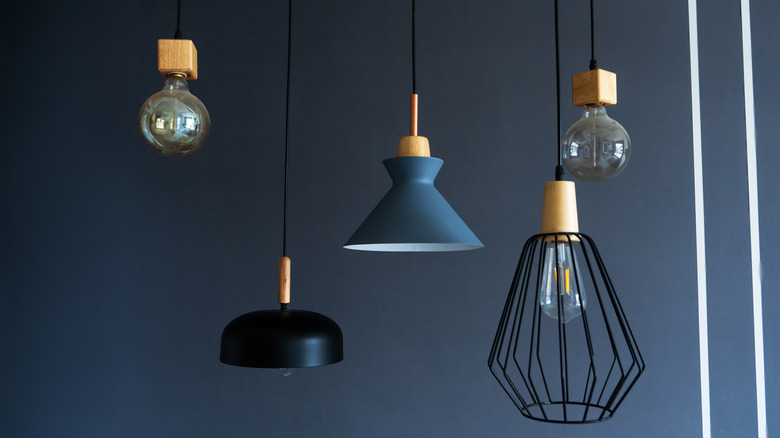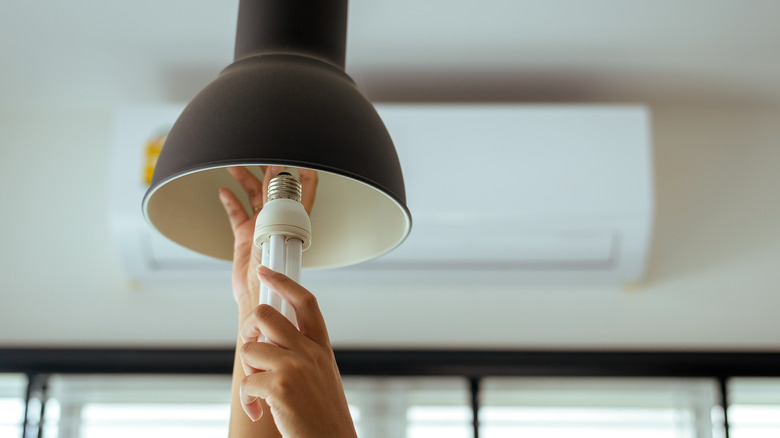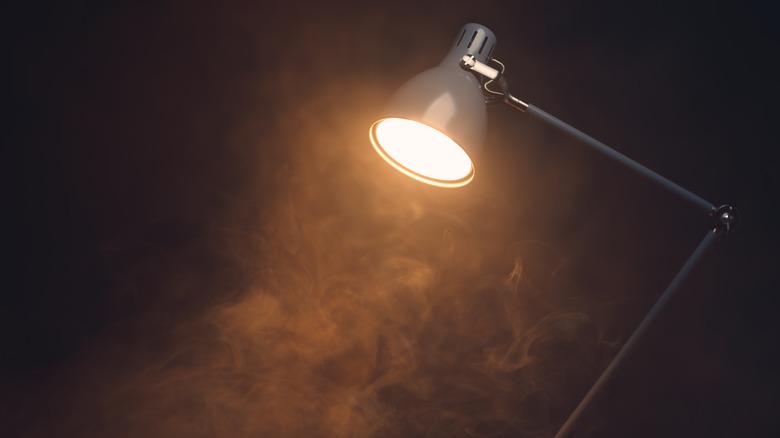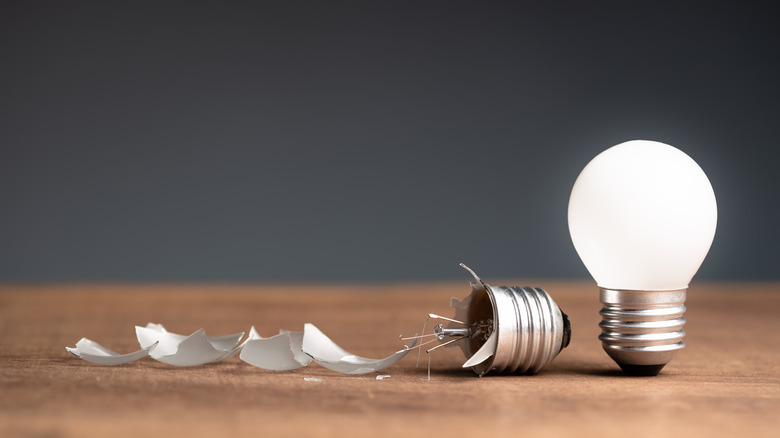Fluorescent Vs. Incandescent Light Bulbs: What's The Difference?
If you're in the market for new light bulbs to illuminate your home, you've undoubtedly come across both fluorescent and incandescent light bulbs. However, not everybody is familiar with the differences between these two popular lighting options. Incandescent light bulbs have withstood the test of time, and have been around in one form or another since the mid-1800s (per Bulb America). Fluorescent lighting, on the other hand, was not invented until 1934 when scientists at General Electric produced the first fluorescent lamp.
While incandescent and fluorescent light bulbs may seem pretty similar at face value, they differ in terms of technology, longevity, cost, energy efficiency, and more. However, the decision will most likely come down to personal preference when choosing one or the other as the best option for your home. If you're trying to decide between fluorescent and incandescent bulbs, read on to find out just exactly how these bulbs differ.
How they work
Incandescent light bulbs create light by heating a metal filament with an electrical current while protecting the filament from outside oxygen via a glass enclosure (per Lamps Plus). By limiting the voltage of the electrical current heating the filament, incandescent bulbs can be easily dimmed using a standard dimmer switch. However, the process in which incandescent bulbs create light makes the bulb very hot to the touch.
Fluorescent light bulbs utilize a much different means of creating light. These bulbs feature a central chamber of mercury, an inert gas, and phosphor powder which is connected to two electrodes (per HowStuffWorks). Light is generated via electrons moving throughout the gas, changing the composition of the mercury in the tube. The end result is a series of colliding charged atoms and electrons that create ultraviolet light. That UV light is made visible by the phosphors that line the bulb enclosure. While fluorescent light bulbs can technically be dimmed, unfortunately, dimming fluorescent light bulbs is usually not as pleasant or simple as using an incandescent dimmer switch.
Color temperature
Although innovations in lighting technology have made incandescent light bulbs an antiquated lighting option in many homes, there are still many homeowners who love the warm, natural quality of the light that they produce. According to ProLampSales, most typical incandescent light bulbs will produce light with a color temperature between 2,700 and 2,800 Kelvin. This type of light is tailor-made for intimate settings such as a cozy living room or den and is typified by an amber warmth that is largely absent in most commercial settings.
Fluorescent light bulbs, on the other hand, are much more versatile in terms of color temperature. With a color temperature range spanning 2,700 to 6,500 Kelvin (per ProLampSales), you can find fluorescent bulbs that emit warm or cool light. While fluorescent bulbs were once rather harsh on the eyes, they have won many fans over the years for the softness and versatility of the light they produce. However, many homeowners still prefer incandescent light bulbs for warm lighting since the warm light they emit is said to feel more natural and inviting.
Bulb longevity
If you're a homeowner with hard-to-reach light fixtures, you probably don't look forward to replacing your light bulbs. In terms of average lifespan, incandescent and fluorescent light bulbs couldn't be more different. According to Senior LED, incandescent light bulbs have an average rated life of 1,000 hours. While this might sound like a long time to some, this easily makes them the least long-lasting light bulbs that you can buy. The short lifespan of incandescent light bulbs makes them an inconvenient choice for light fixtures that remain on throughout the day, as well as most commercial lighting needs. However, when used once in a while for subtle accent lighting (which these bulbs excel at due to their warm color), incandescent light bulbs can give you a decent bang for your buck.
Fluorescent light bulbs, on the other hand, last roughly eight times longer than incandescent light bulbs on average. Sporting an average lifespan of 8,000 hours, these are a fairly cost-effective lighting option for always-on light fixtures, business use, and everyday home lighting.
Cost and energy efficiency
In terms of upfront cost, incandescent light bulbs are the most affordable lighting option on the market at roughly 94 cents per bulb (per Green Living Ideas), with CFL (Compact Fluorescent Light bulbs) trailing behind at $1.60 per bulb. However, the affordability of incandescent light bulbs is called into question once you consider their limited lifespan and poor energy efficiency.
According to Energy Use Calculator, a fluorescent light bulb is $8.39 cheaper than an incandescent light bulb in terms of its yearly energy cost when left on for five hours a day at a rate of 10 cents per kilowatt hour (kWh). Given rising energy costs, the yearly energy savings of lighting an entire household with fluorescent light bulbs over incandescent ones can be significant. Factor in the superior longevity of fluorescent bulbs, and they are overall a much more affordable lighting option than incandescent lighting.
Health concerns
Some types of light bulbs are less healthy for your body and the environment than others. According to Popular Science, incandescent light bulbs can't be considered particularly healthy for the environment due to their poor energy efficiency. It's easy to see why, given the fact that artificial lighting accounts for a sizable portion of global power usage (per the U.S. Department of Energy). Incandescent light bulbs can also be a burning hazard since they run so hot and thus should be kept out of reach of young children. However, the warm light that incandescent bulbs emit is less harmful to your eyes and sleep cycle than many other types of light bulbs.
While fluorescent bulbs are better for the environment, there is evidence to suggest that they might be less healthy for humans in some ways. According to the National Library of Medicine, fluorescent lighting has been linked to an increase in UV-related eye diseases such as cataracts and pterygia. Also, fluorescent bulbs contain mercury gas, which can be harmful to humans if they are exposed after breaking a fluorescent light bulb.





